Public relations (PR) is a field that incorporates many facets – and many fables. It is about creating a public image that reflects the core message a company wants to send, whether this is for a one-off event or a longer-term, brand-building exercise.
At its best, it operates as an open partnership, using information provided by the company about its target market and desired positioning, and results in positive media coverage, enhanced brand positioning and increased sales.
Before choosing a PR agency, it is important to recognise what PR is not.
It is not a replacement for a marketing plan. A successful PR campaign works best when it is based on a well-researched marketing plan that has already been established by the company.
PR is not the same as advertising. Many people are confused about the difference between publicity and advertising, says Christine Smith-Mann, owner of Smith-Mann Communications (SMC), which provides PR, marketing and event management services.
“They think you have control over what is written and when. Publicity is completely free, but you have no control over it. With advertising, you have complete control because you pay for it.”
Finally, PR cannot operate effectively in a vacuum. It needs the full support of your company, before, during and after the campaign.
“You can’t have just PR,” says Lynn Grebstad, partner at Grebstad Hicks Communication (GHC), a Hong Kong-based PR agency that specialises in luxury travel, tourism, hospitality and lifestyle, with offices in Beijing, Shanghai, Singapore and Bangkok.
“It’s got to be supported by other things, like customer service. It’s pointless for us to produce a beautiful press kit and there’s nobody there to follow up with enquiries about sales and that sort of thing.”

Preparing the brief
So, before choosing a PR agency, you need to do some homework. Decide on your objectives, your budget and your timing. Ask yourself, what is your customer profile? Who are you trying to reach? Where do you want your brand, event or product to be positioned? How much time and money do you have available?
Prepare all this information as a written or verbal brief to present to potential PR partners at your first meeting. It will help you to focus clearly on the kind of PR service you need – and the PR agency will expect it.
“We must have a brief, a verbal brief or a written brief, basically telling us where they are now, where they want to be, what sort of investment they want to make in terms of time, money, who they want to reach – we need to have very clear guidelines as to their consumers, their customers, their target audience,” says Grebstad.
“I always ask, where are you now and where do you want to get to?”
Clients should provide their agency a comprehensive briefing on their business so that the agency can craft substantive key messages and stories and be able to explore the full range of story angles, says Cathy Chon, founder and managing director of CatchOn, a strategic marketing communications consultancy that offers brand development, strategy development, marketing plans and media relations services in the hospitality, leisure, and luxury sectors.
“A comprehensive briefing includes not only PR objectives and KPIs [key positioning indicators], but also an understanding of the competitive landscape, the client’s positioning, et cetera,” she says.
Sharing your business plan with the agency can also help it understand your ongoing and future plans, as well as your immediate needs. This will help to shape the scope and targets of the campaign.
“For example, if you know that a restaurant will open five more restaurants in a few years, it makes for a good business story that’s not just about food and could be about, for instance, franchising,” explains Smith-Mann.
That means that, instead of targeting simply lifestyle and food media, the agency could also set up interviews with business magazines, greatly expanding the reach of your campaign.

Starting the selection process
Once your brief is ready, you can consider the agencies you would like to work with. Find out what the company has done before for clients and if their experience is compatible with your business. They have to have the right sort of contacts on hand to promote your offering.
“Don’t just try to work with a friend who’s in public relations. It’s all about ROI [return on investment] and we should never forget that,” advises Grebstad.
Chon says: “A client should choose based on a number of factors: the agency’s track record; their working philosophy or approach; core competencies; the quality of the team – especially the one that will eventually be assigned to work on your account, not the one who pitches it.
“Ultimately, they should seek out what former and current clients and members of the media say about the agency. This is the ultimate litmus test.”
A company presentation should leave you with a clear picture of what the company can do for you and what they have achieved with other clients.
Grebstad explains: “In our presentation, we’ll give them a backgrounder on our company – our scope of services. We will show them case studies of projects that we’ve done, or relationships that we’ve had with clients like themselves in the past, our success stories with them. And then we build in a component of what we think we could bring to them.”
She says a presentation happens after a briefing has been received and the company has done some research on the market. “So we give them a bit of a roadmap. A lot of clients are very savvy about their products, they’re very savvy about where they want to be, but they’re not savvy about the media.”
Deciding on whether to work with a large or a small agency depends on your needs, says Smith-Mann. Choosing a smaller, niche agency, with a speciality in your area of business or in the special requirements of your event, can work well, whereas larger agencies can typically handle all PR and marketing requirements, including advertising, media relations, events management and public relations.
Small agencies like CMC can offer specialisation, more personal service and top-level handling of your account. “The principals are actually carrying out the work for you, rather than junior staff,” she says. “That’s important for both the quality of service you’re going to get and the assurance that your needs and concerns will be listened to. Emotionally, you like to know that who you meet with is who is going to be working on your account.”
Beyond the purely business aspects, it’s important to choose an agency staffed by people you can get along with. Bear in mind that openness and a constant stream of communication between your company and the PR agency will be essential, often for a period of months or more. If the personal chemistry isn’t right from the first meeting, it’s probably wise to look elsewhere.
PR agencies will also not hesitate to turn down your business if you present a know-it-all approach that signals you might be hard to work with.
Working with a PR agency
Deciding on how to divide up the work between what is to be done in-house and what is to be farmed out to the PR agency can be treacherous, say PR agencies and clients alike.
“The best and most productive relationships come about if the client takes on their agency as a partner,” says Chon. “Involve us early in the planning process, spell out objectives and expectations; allow for sufficient turnaround time and a reasonable budget.
“Most importantly, give the agency appreciation and praise where and when it’ due, especially the junior staff who do a lot of the tedious work. They will make that extra effort to do a great job if everyone is motivated and feeling appreciated. Finally, clients should encourage and foster teamwork and they will immediately see the benefits in the agency’s work.”
Grebstad points out that a clear communication line is essential. The company should have a team in place with people who can coordinate with the PR agency.
“It’s really very important to have a line of communication to a client. It would be either the marketing or PR manager [or owner’s assistant] – a conduit to the decision maker,” says Grebstad.
Measuring success
While in many companies it is a requirement to measure PR success with US dollars, it is not always easy to pin down all the advantages a PR company can bring. “Actually, it’s hard to measure what we do,” says Grebstad.
“You can measure it in terms of you spent US$10,000, and we got you US$30,000 worth of advertising. But that’s not the only way of measuring it.
“It’s basically building up brand recognition and, of course, the most important thing is seeing how market share can rise as a result of your efforts.”
CREATING BUZZ
When the W in Taipei opens on February 14 this year as a Valentine’s Day gift to Taiwan, it will be the result of a close collaboration between the hotel’s internal and external resources. But finding the right PR agency to work with was not easy, says W’s general manager Cary Gray.
While Gray was very happy with the Starwood network and the local marketing strategy implemented by his in-house marketing and communications manager, Wina Chan, who had excellent contacts and relationships with the local media, he felt a broader approach was needed for the launch.
“When doing the proposal, we were looking at the need for regional coverage to address an estimated 65 per cent of the market and the US because that’ll be about 25 per cent of what our market will be. Being W and W being so much about buzz, it seemed to me we needed the assurance of widening our embrace of the local media to include regional and US media partners.”
“In the past, the company’s PR agencies were appointed following recommendations from within our company and other partners, but that had not always been successful,” he says.
“… Frankly, in my experience the selected PR agencies have been very disappointing, as they covered dozens of hotels and lost the focus on an individual property.”
With four hotel openings under his belt, Gray wasn’t about to make the same mistakes this time. He put together a “fairly rigorous” request for proposals, and carefully scrutinised the subsequent presentations made by selected PR agencies to see whether they could meet his needs. He also looked for concrete examples of their previous work to support the claims made in their proposals.
With the solid assistance of Starwood, he chose a PR agency called GNC with offices in Singapore and San Francisco. The work share is divided smoothly between his staff and Hwee Peng Yeo, the representative of the PR agency, he says. “It’s really a collaborative thing: the power of Starwood, the power of our property specific team and with GNC. The ideas, strategies and suggestions have been garnered from all parties and, as we gain consensus and agreement, it usually takes the resources of all sides to execute and bring the ideas to fruition.”
The experience has provided valuable training and exposure to his staff. “This opportunity is a great experience for Wina and the marketing communications team, in the sense that they have had the exposure and knowledge locally and somewhat regionally, but this collaboration has raised everyone’s game to a new level. The results speak for themselves. We have raised the buzz about W Taipei exponentially. The property team has broadened their awareness and increased their skills to where Wina and her team are a much more rounded PR power.”
CHOOSING A PR PARTNER
Check if the company has
• Outstanding track record
• Compatible experience
• The right contacts and database
• Working philosophy
• Relevant core competencies
• High quality team
• Adequate scope of services
• Required size


